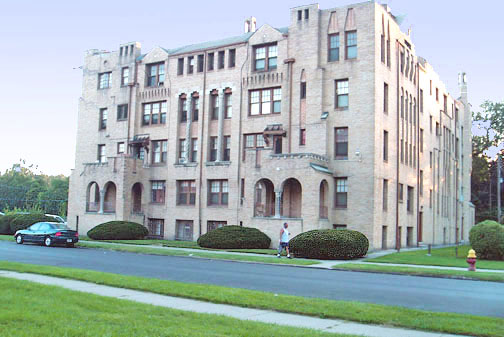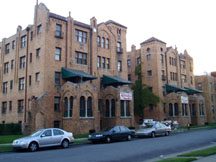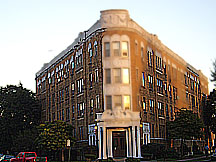

The city of Detroit has dozens of fascinating and attractive neighborhoods, but in my view, this is one of the most interesting you will find in any large American city. Publishers specializing in art and architecture often produce “coffee table” books for the holiday season—books that you page through to examine the best works of an artist or designer. You can imagine someone preparing a book that would illustrate the most stimulating design used for low-rise apartment buildings between about 1924 and 1950. You could page through that attractive book and be moved by the ingenuous design of some architects and also by the valiant, but unsuccessful, attempts of others.
Instead of paying scores of dollars to purchase such a book,
the next time you visit Detroit you might walk around the Palmer Park Apartment
Buildings Historic District. As the National Register of Historic Places website
notes, here you will find exotic architecture in the Egyptian, Spanish, Venetian,
Moorish, Tudor and Mediterranean styles. Few urban neighborhoods in the US offer
as much architectural stimulation.
Thomas Palmer was a prosperous land developer who represented the city in the Michigan Senate, and then Michigan in the US Senate in the 1880s. He served as US ambassador to Spain in the second Harrison administration.
In the 1880s, Palmer developed a 650-acre estate for his family called Walnut Lane and located to the immediate west of Woodward between McNichols and Eight Mile. He devoted a major proportion of his property to the city for the impressive Palmer Park.
Palmer decided to develop his homestead. This is the area now
known at the Palmer Park Apartment Building Historic District. He made little
progress before he died in 1913. Subsequently, the land was purchased by Walter
O. Briggs, the prospering body manufacturer and future owner of the Detroit
Tigers. After the vehicle boom made Detroit the fastest growing major city in
the nation, a need arose for much more housing. The greatest apartment boom
in the city’s history occurred in the 1920s. Many beautiful structures
went up along East Jefferson. 
Walter Briggs decided to develop the former Palmer estate into a low-rise apartment area. It was an especially desirable location—near Palmer Park, close to Highland Park where Ford and the emerging Chrysler firms were location and very convenient to the city’s Central Business District.
Albert Kahn designed the first apartment to open: Walbri Court Apartments at 1001 Covington. By 1965, about 39 additional buildings filled this neighborhood. An especially interesting illustration of the architect’s ken is The Whitmore Plaza apartment at 300 Whitmore designed by Weidmaier and Gay in 1928 using an Art Deco theme that incorporates Moorish influences. The Palmer Park Apartments at 900 Whitmore were designed by Robert West, opened in 1938, and may be Detroit’s best representation of the Bauhaus modern design that was so popular in Germany in the late 1920s and 1930. Temple Israel—now St. Paul Life and Praise Center Church—at 17400 Manderson and designed by William Kapp—offers an Art Deco interpretation of an Egyptian temple.
The Palmer Park Apartment Buildings Historic District in Detroit is different from the adjoining but distinct Palmer Park Boulevard Apartment District in Highland Park and located at 1981, 2003 and 2025 West McNichols.
Architects: Many represented beginning with Albert Kahn.
Dates of construction: 1924 through the early 1950s.
Architectural styles: Many
Use in 2004: Apartment buildings
City of Detroit Local Historic District: Not listed
State of Michigan Registry of Historic Sites: Not listed
National Register of Historic Places: # 83000895: Listed: May 21, 1983
Photograph: Ren Farley; September, 2004
Return to National Register of Historic Places
Return to Michigan Registered Historic Districts